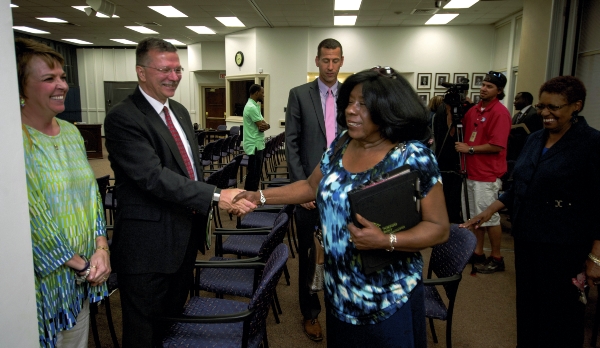Darts & laurels: New chief, new solutions?
Published 12:00 am Saturday, June 11, 2016

- Jerome Stokes, center left, was introduced as the new Salisbury police chief at a City Council meeting on Tuesday evening. Stokes shakes hands with DeeDee Wright after his announcement. Currently deputy chief in Lynchburg, Va., Stokes will start his new job in Salisbury on July 18. Jon C. Lakey/Salisbury Post
Laurels to the appointment this week of a new police chief for the city of Salisbury. One of two deputy chiefs in the Lynchburg, Va., Police Department, Jerome Stokes will start his Salisbury job next month with decades of experience behind him. That’s good, because ahead of him lie stubborn challenges, including one much talked-about during the public comment portion of Tuesday’s meeting: continuing violence in the West End. One by one, six residents complained to the council about ongoing gunfire, boarded-up houses, unsolved murders and more — an all-too-familiar story. “We’re living in a state of emergency,” Ollie Mae Carroll said. More than one person suggested calling in the National Guard. A new chief can hardly equate with the National Guard, but if Stokes can recruit and retain a full police force, he’ll make big strides in improving the city’s law enforcement.
Salisbury is not alone. A decade ago, a state study found that police agencies across North Carolina experienced an average turnover of 14 percent in patrol positions; the average tenure for a new officer was 33 months. The statistics might be worse now, especially for small cities that cannot offer the kind of pay available in the booming metro areas. The Salisbury Police Department needs a morale boost, more officers and decisive, strong leadership. Welcome and good luck, Chief Stokes.
• • •
Dart to a primary season so confusing that a 9 percent voter turnout is impressive. Think about it. Usually North Carolina primaries are held in May. This year, legislators moved the primaries to March so the state could be more of a player in the presidential race. Votes on congressional seats in that primary were invalidated, however, by the legal back and forth over gerrymandered districts. So another primary was held June 7 for the newly drawn congressional districts. Rowan County went from being in the 5th, 8th and 12th districts to just the 8th and 13th. Honestly, you had to work at it to figure out which congressional district you lived in and who the candidates were — a challenge compounded by the large field of 17 Republicans and five Democrats in the 13th.
The June 7 ballot also included a nonpartisan N.C. Supreme Court race that was tacked on because the Republican effort to have an associate justice re-elected by a mere a yea-or-nay “retention” vote did not pass constitutional muster.
It was a bizarre primary. The good news out of all this is the new congressional districts make more sense than the old ones and that Associate Justice Bob Edmunds has to go through a real election. Only political junkies can keep track of the minutiae of modern politics, though, leaving most people to be swayed by slick, PAC-financed advertising. You’d think someone designed it that way. Uh-oh.


